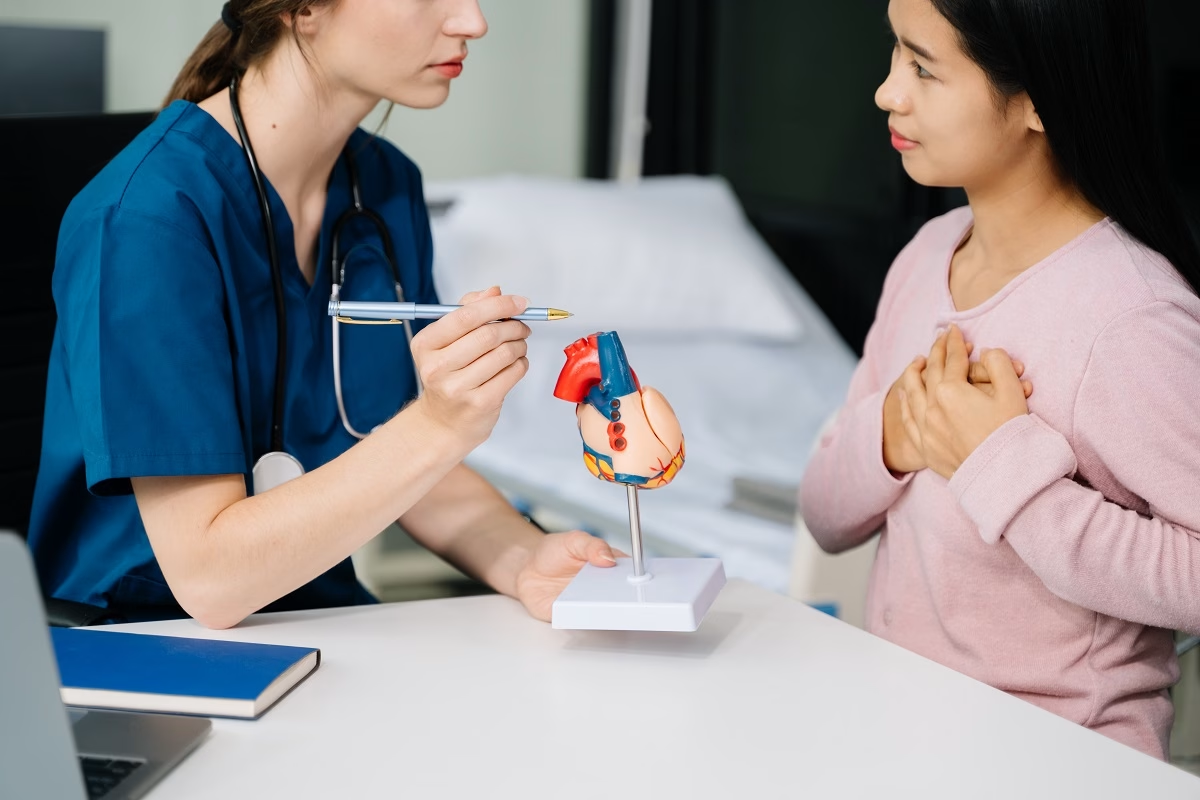A health condition in which a hole appears in the wall between the lower chambers of the heart is known as a ventricular septal defect (VSD). If the hole becomes large, it may cause permanent damage to the heart due to the leakage of blood between the ventricles (the lower heart chambers). It may also increase your risk of developing heart and lung infections. However, in most cases, this hole in the heart does not cause symptoms and closes on its own after 6 years old. In other words, this hole between the ventricles allows the oxygen-rich blood to mix with oxygen-poor blood. Generally, the heart works better when the wall prevents blood from mixing.
Furthermore, VSD is the most common congenital (present at birth) heart disease, and it usually occurs along with other heart problems. While a small hole closes itself and does not cause symptoms, if you develop a large hole, you are at increased risk of permanent damage to the heart muscle and serious complications without treatment.
Usually, this condition is diagnosed during childhood and less commonly during adulthood because the hole closes itself during childhood.
Types of Ventricular Septal Defect
In general, physicians have divided this condition into 4 types according to the location and structure of the hole. These include:
- Membranous – In most cases, this type affects babies, and it occurs in the upper section of the wall between the lower chambers of the heart.
- Muscular – In such cases, the hole develops in the lower part of the wall that separates the ventricles.
- Inlet – In people who develop this type of VSD, the hole appears below the tricuspid valve in the right ventricle and the mitral valve in the left ventricle.
- Outlet – This type of ventricular septal defect makes the hole develop before the pulmonary valve in the lower right chamber of the heart.
Symptoms
In some cases, the symptoms of VSD look similar to heart failure in newborns. Check below some symptoms that often appear in people with a ventricular septal defect:
- Shortness of breath
- Fatigue (extreme tiredness) during feeding
- Slow weight gain (also known as growth faltering)
- Multiple respiratory infections
If the condition is not diagnosed until late childhood or early adulthood, it may cause tiredness and breathing problems, especially during physical activity.
In most cases, people with this heart condition do not have symptoms, and the hole is around 3 millimeters. The symptoms do not appear because the hole is too small to cause them. When the hole becomes too large (some people may develop multiple holes), the blood begins to leak between the ventricles. In moderate cases, the size of the hole is about 5 millimeters, and a severe form of VSD causes a hole from 6 to 10 millimeters. Commonly, people with moderate to severe VSD experience symptoms.
Causes
Nowadays, experts do not know why this condition occurs. However, VSD often appears along with other congenital problems, including other heart defects, genetic disorders (such as Down syndrome), and others.
Rarely, a myocardial infarction (heart attack) may cause a hole between the lower chambers of the heart, which leads to VSD. Generally, the cause of this type of VSD is considered an adverse reaction. Anyway, people who develop VSD after a heart attack should get immediate treatment to prevent serious complications.
Risk Factors
Healthcare professionals have identified some factors that could increase the risk of the baby developing VSD. For example, this condition mostly occurs in babies who were born prematurely or have certain genetic disorders. Furthermore, the risk also increases when the mother takes anti-seizure medicines (such as Valproic acid and Phenytoin) or drinks alcoholic beverages during pregnancy. In any case, more research is needed to confirm these risk factors. Check below for other risk factors:
- A family history of VSD
- Genetic syndromes
- Environmental factors (such as prolonged exposure to certain chemicals and toxins)
- Stress
- Maternal infections (including rubella)
What Are The Possible Complications of a Ventricular Septal Defect?
When blood begins to leak, the heart muscle does not pump efficiently. Thus, the heart muscle needs to pump harder to supply the body with oxygen-rich blood. If the heart works harder for long periods, it may lead to damage to the heart muscle and certain complications.
If a child with VSD does not get treatment, it may lead to Eisenmenger syndrome, which may cause permanent damage to the blood vessels in the lungs. Check below for other complications:
- Enlarged ventricles
- Leaky aortic valve (also known as aortic regurgitation)
- Heart failure
- Endocarditis
- Irregular heart rhythm (arrhythmia)
- Stroke
- Pulmonary hypertension
- Development and growth problems
- Sudden cardiac death
Discuss with your healthcare professional about ways to reduce the risk or prevent previous complications if you have a child with VSD.
Diagnosis
Some people do not need treatment for VSD because the hole is small and does not cause symptoms. However, if your child develops a moderate to severe type of VSD, you should see a doctor immediately. Early diagnosis and proper treatment may help prevent life-threatening complications.
Physicians often begin with a physical examination and questions about the family history and symptoms. They usually suspect a VSD during a physical exam when listening to the heart with a stethoscope and hearing a sound known as a heart murmur. Doctors may also perform certain imaging tests to determine the exact location and size of the hole. Check below some tests often used to check for changes in the heart structure:
- Cardiac catheterization
- Echocardiogram
- Electrocardiogram (ECG or EKG)
- Chest X-ray
- Cardiac CT (computed tomography) scan
- Cardiac MRI (magnetic resonance imaging)
Treatment
Usually, doctors prescribe different treatments for people with VSD because it depends on several factors. For example, the severity and type of the condition, overall health, age, and preferences. However, they commonly prescribe medicines, procedures, and surgery to treat the hole caused by VSD. In severe cases, if the child does not get treatment, it may lead to permanent damage to the heart muscle.
Medicines
The following medicines may help people with moderate VSD and reduce the symptoms. Sometimes, doctors may recommend the medicines listed below before surgery. Usually, they prescribe medicines similar to those used to treat heart failure. Examples include:
- Diuretics – This group of medicines is used to prevent fluid buildup around the heart.
- Heart failure medicines – These medications are used to control the time and strength of the heartbeat.
Surgery and Other Procedures
Check below for the most common options to repair a ventricular septal defect:
- Transcatheter procedures – During these procedures, physicians use a long and flexible tube (catheter) that is inserted through a major artery and then guided to the heart.
- Surgery – This procedure is used to patch or close the hole. Surgeons often use a patch made of synthetic material to close the hole.
After surgery, this synthetic material will be a part of the heart wall. While some people recover within a few days to 1-2 weeks, sometimes the recovery time may last up to several months.
Frequently Asked Questions
When should I see my healthcare provider?
If you notice any of the following symptoms, immediately visit a doctor. For example:
- Frequent infections of the respiratory tract
- Breathing problems or fussiness
- Tiredness
- Delayed growth
What is the life expectancy of a child with VSD?
In mild cases, people have the same life expectancy as those without this condition. However, if your child develops a moderate to severe form of the disease, he/she may have a reduced life expectancy even after successful surgery.
Can people with a VSD live a normal life?
If the child develops a mild form of the disease, he/she can live a normal and healthy life. When the condition causes a moderate to large hole, you may need regular checkups and treatments to reduce the symptoms and prevent serious complications. Ask your healthcare professional if you have additional questions.




